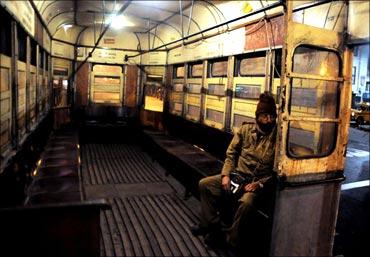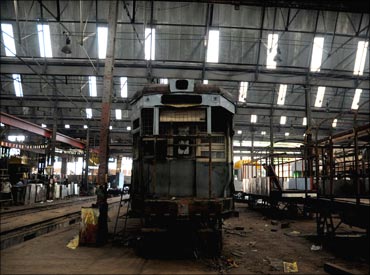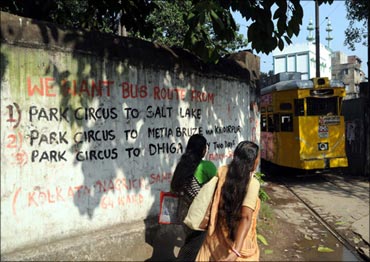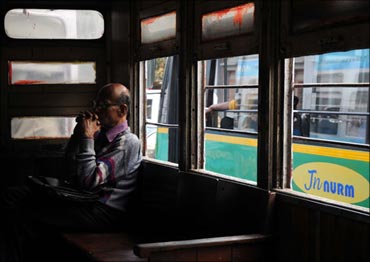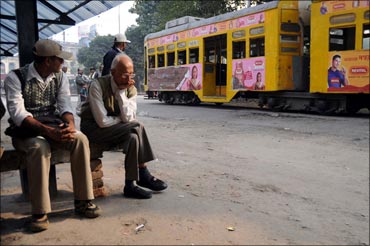 | « Back to article | Print this article |
How Kolkata's iconic trams plan to stay afloat
Two decades ago, Calcutta Tramways Company, which operates Asias oldest functional tram service, stepped out of its dedicated segment to launch a bus service.
However, as the new venture only added to the company's financial liabilities through the years, the cash-strapped, state-run transport corporation now plans to explore the water route in search of a turnaround.
The plan, chalked by the West Bengal government and CTC, envisages ferry services on the Ganges between Barrackpore in North 24 Parganas and Babu Ghat in Kolkata.
"Chief Minister Mamata Banerjee wants to popularise ferry services on the Ganges.
"For this, we have submitted a proposal and are awaiting a green signal from the state government," CTC chairman Shantilal Jain told Business Standard.
Click NEXT to read further. . .
How Kolkata's iconic trams plan to stay afloat
"Initially, we plan to run 60-seater speedboats over the Ganges -- from Barrackpore to Babu Ghat. These would connect the Liluah, Bali, Belur and Howrah stations," he said.
In the proposal, CTC has stated an initial requirement of eight 60-seater speedboats, including two air-conditioned ones.
The transport corporation is also considering roping in private partners for the venture. "Each speedboat would cost about Rs 50-60 lakh (Rs 5-6 million).
"So, we need financial support.
"There is also a proposal to adopt a public-private-partnership model.
"We have initiated talks with interested partners and are hopeful the new venture would help us become self-reliant," Jain said.
Click NEXT to read further. . .
How Kolkata's iconic trams plan to stay afloat
"We have received the proposal. However, first we need to rebuild the respective jetties to introduce the service," said a senior transport ministry official.
CTC began operations in 1880 with a metre-gauge, horse-drawn tram.
This gave way to electric trams in 1902.
In 1992, the company expanded its operations by introducing a bus service in the city.
Officials say 'excess-workforce', 'stagnant fares' and 'introduction of the metro service in the city' turned the company into the state's 'biggest loss-making' transport agency.
According to the state transport department, though CTC earns about Rs 50 crore (Rs 500 million) a year from its tram and bus services, it spends a lot more on salaries to its workforce of about 6,500.
Click NEXT to read further. . .
How Kolkata's iconic trams plan to stay afloat
The state government has been providing annual subsidies of Rs 600 crore (Rs 6 billion) to the five state-run transport corporations -- Calcutta State Transport Corporation, North Bengal State Transport Corporation, South Bengal State Transport Corporation and West Bengal Surface Transport Corporation.
CTC accounts for about Rs 200 crore (Rs 2 billion) of the subsidy.
Currently, CTC operates 125 trams in Kolkata, carrying about 15,000 passengers a day. It also runs 240 buses in the city and its suburban areas, accounting for about 50,000 passengers a day.
Click NEXT to read further. . .
How Kolkata's iconic trams plan to stay afloat
The daily revenue from tram services is about Rs 60,000, while that from the bus service is about Rs 300,000.
Meanwhile, CTC has already initiated steps to boost revenue through services like plying buses on profitable routes and an on-board ticket checking system.
The state transport and tourism departments have also come up with a plan to convert four trams into 'cafeteria trams' by October.
Introducing air-conditioned buses and turning underutilised tram depots in the city's prime locations into parking lots is also on the agenda.
